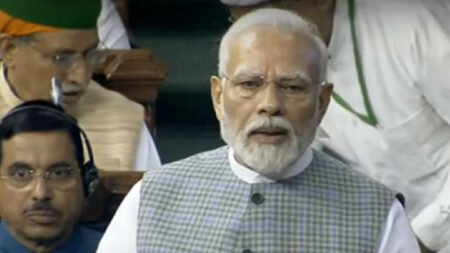The Assam Government celebrated the 400th birth anniversary of the legendary icon of Assam who had restrained the Mughal army on multiple occasions.
On November 23, a three-day celebration was organized at Vigyan Bhavan where PM Narendra Modi and Union Minister Amit Shah will be attending the event said Assam Chief Minister Himanta Biswa Sarma.
He also added that International seminars and an exhibition will be organized and a book will be dedicated by the Prime Minister to the commander of the nation on November 24. Amit Shah inaugurated a documentary film on Lachit Borphukan.
Sarma also told that the documentary will be telecasted on various regional, national, and international TV channels.
The seminar organized was attended by 200 history students from different colleges in Assam. Replicas and artifacts will be exhibited in the exhibition.

PM Modi pays tribute to Lachit Barphukan
On November 25, PM Modi while addressing the ceremony said that we have received an opportunity to celebrate the 400th birth anniversary of the legendary icon of Assam in the time country across celebrating the Amrit Kaal of its Independence.
In his speech, PM Modi said, “We received the opportunity to celebrate the 400th birth anniversary of Lachit Barphukan at a time when the country is celebrating the Amrit Kaal of its Independence. This historic occasion is a proud chapter in the history of Assam.”
“Great personalities like Lachit Barphukan and immortal offsprings of Bharat Maa are our constant inspirations for the fulfillment of the resolutions of this Amrit Kaal,” PM Modi added.
Assam’s Chief minister announced that a grand memorial will be set up at the Lachit maidan, Jorhat, Assam.
24th November is celebrated as Lachit Diwas every year. Finance Minister Nirmala Sitharaman inaugurated the exhibition.
Assam Chief Minister said that Indian History ignored the heroism of Ahoms and Lachit Borphukan and many others in the country. People of the country should be aware that if Lachit Borpuhkan wouldn’t fight the Mughals history would have been entirely gone on a different path. If the legendary Ahom general hadn’t inflicted a crushing defeat in the 1671 battle of Saraighat against the Mughals then Northeast would have been completely different.
The Mughal Ahom battle
The Mughal empire had tried to conquer Assam for more than 60 years in the 17th century which ended after the battle of 1671 in which the Mughals were defeated by Ahoms. As per information, there were 17 wars between the Ahoms and the Mughals. A maximum number of wars were won by Ahoms. In 1663 the Mughals were Ahom’s capital and won a major war then.

The conflict had begun after the split of Cooch Behar after the second ruler Nara Narayan’s death. The Cooch Behar kingdom lay between the Ahoms and the Mughals so the western part was ruled by Nara Narayan’s son Lakshmi Narayan allied with the Mughals and the eastern part Koch Hajo ruled by Raghudev allied with Ahoms.
The Koch Hajo is included in today’s West Assam region. While Koch Behar is included in today’s North Bengal region.
After gaining Koch Behar, the Mughal’s ambitions rose and they wanted to conquer the whole of Assam. In 1615, the Ahom kingdom captured and punished a trader Ratan Singh for illegal trade and was later expelled from Assam, it was the first time that the Mughals and Ahoms encountered each other. Ahoms
had to suffer a few losses at the start but eventually defeated the Mughal army.
The Saraighat War
Ahoms had lesser manpower and resources as compared to the Mughals but the Mughal’s difficulty gave an edge to the Ahoms.
The Mughal army had arrived at the Western frontier of Ahoms Kingdom in 1671. The Ahom army was waiting for them there. Lachit Borphukan acknowledged that it was impossible to defeat the Mughals on land and knew that they were weak on the water. Ahom army was a proficient naval fighter on the water.
Lachit Borphukan made a strategy to defeat and stop the Mughals at Saraighat, Guwahati. As the river is just 1 km wide and is the narrowest place. He built multiple mud walls around Guwahati to pressurise the Mughals to get in the river.

Due to construed walls, the war had shifted on the river but Lachit Borphukan became severely unwell and couldn’t be a part of the war. This demoralized the Ahom Army. Initially, the Mughals were winning, looking at this Borphukan jumped into the war and lead the army.
Despite his being unwell he led the army heroically and there was an intense battle between the Ahoms and the Mughals.
Doctors had asked Lachit to not go on the battlefield as his health deteriorated but he considered his health secondary and his responsibility to protect the people as his priority.
Ahom’s army launched huge attacks on the invaders. Mughals became leaderless after Mughal Admiral Munawar Khan was killed by a gunshot. They had to eventually retreat after the death of several top leaders.
Lachit Borphukan had used astute guerilla tactics, subterfuge diplomacy, daring, and psychological combat to strike the Mughal Army. The Saraighat battle was one of the factors which led to the fall of the Mughals after which they never attempted to capture Assam.
Read More: CBI files Chargesheet against 7 people accused in the Delhi Excise Policy Scam













